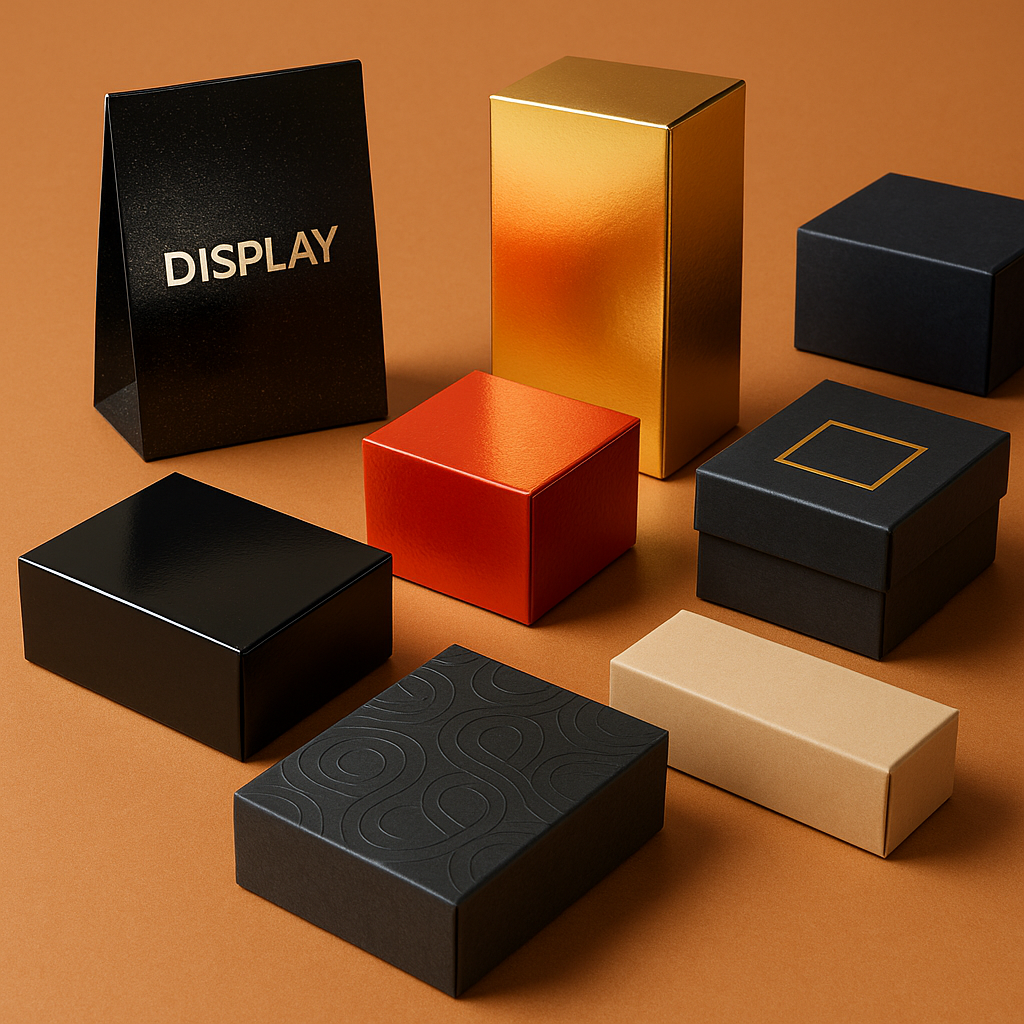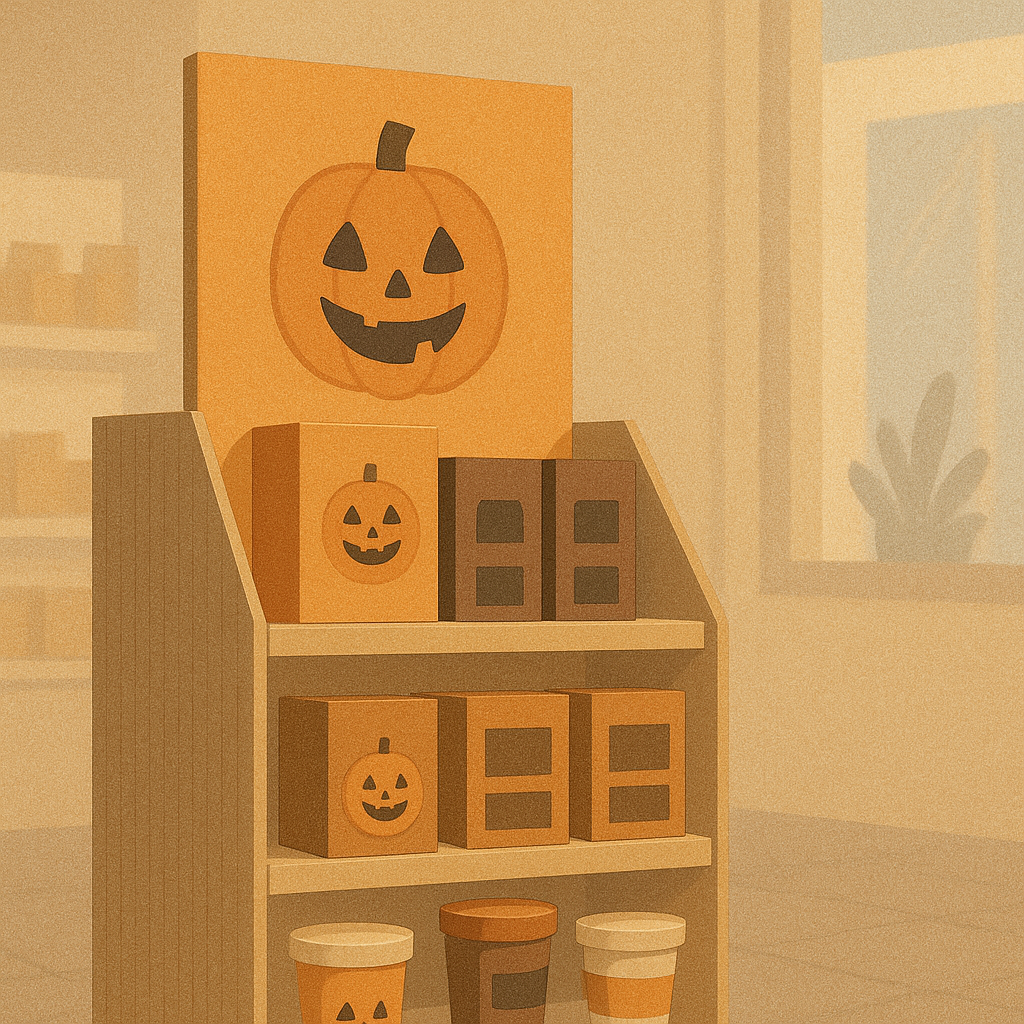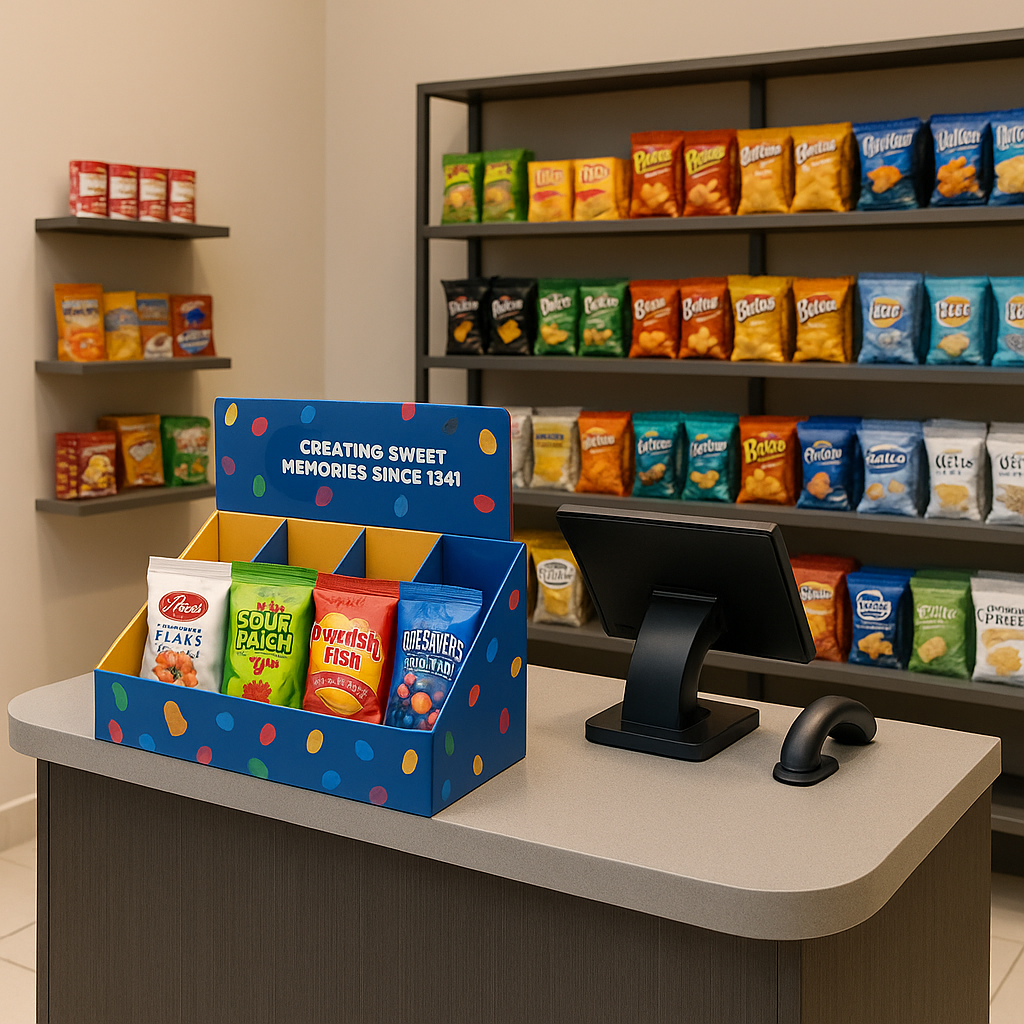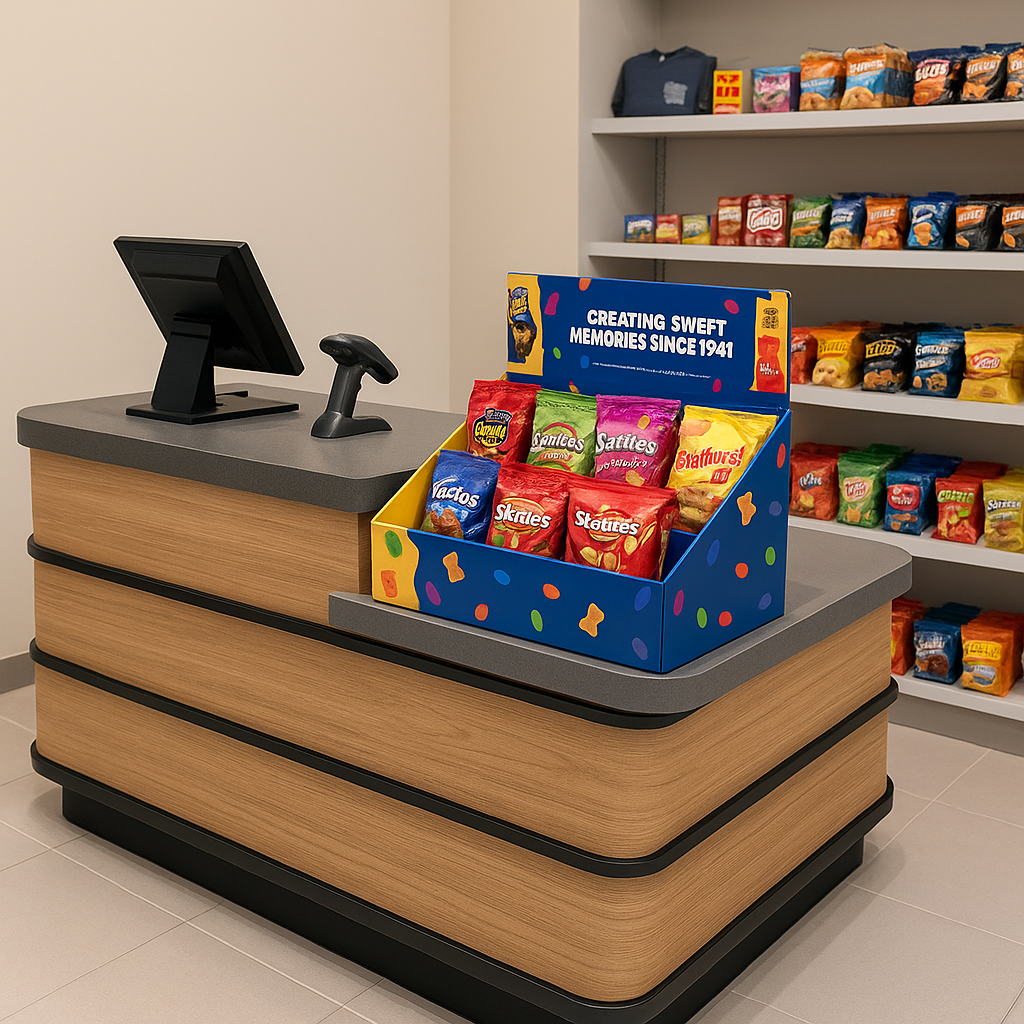
How Surface Finishes Transform Paper Boxes and Displays Into Customer Magnets
Discover how lamination, UV coating, and foil stamping elevate paper boxes and display stands—captivating customers with premium appeal and boosting brand value.
Back to blogs
Packaging isn’t just about holding a product it’s a silent salesperson. In fact, nearly 72% of consumers say packaging design influences their purchase decisions. For brands, especially in competitive retail environments, the look and feel of a paper box or cardboard display can make the difference between catching a customer’s eye or fading into the background. Surface finishing techniques like lamination, UV coating, and hot foil stamping are the secret weapons behind many attention-grabbing packages, turning ordinary cardboard into a canvas of shimmer, texture, and gloss. These finishes not only enhance visual appeal but also signal quality, influence perceptions of value, and even engage customers’ senses on a deeper level. Meiyastand, as an expert in custom paper packaging and displays, leverages these techniques to help brands create truly magnetic customer experiences.
A variety of paper boxes and display packages showcasing creative surface finishes from high-gloss coatings to metallic foils and embossed textures which collectively elevate visual appeal and invite customer interaction.
Whether you’re a brand manager planning your next product launch or a consumer drawn to beautiful packaging, it’s worth understanding how these finishing touches work. Below, we dive into each technique lamination, UV coating, and foil stamping and reveal how they boost marketability and perceived value. We’ll also explore how combining finishes can amplify brand presence, and how modern innovations are making these effects more sustainable. By the end, you’ll see how surface finishes can transform simple paper boxes and displays into customer magnets that stop shoppers in their tracks.
Lamination: Enhancing Durability and Aesthetics
Lamination is one of the most common finishing techniques for paper boxes and printed displays. In this process, a thin film (often a clear plastic layer) is bonded to the printed surface. This laminated layer serves two main purposes: protecting the packaging and elevating its appearance. By shielding the ink and paper beneath, lamination guards against scratches, moisture, and general wear ensuring that a box looks pristine on the shelf even after shipping and handling. At the same time, lamination can dramatically change the look and feel of the packaging. Gloss laminations impart a shiny varnish-like finish that makes colors appear more vibrant and saturated, giving the packaging a bold, eye-catching sheen. In contrast, matte laminations produce a smooth, glare-free finish that feels velvety to the touch, lending an understated sophistication and “soft-touch” elegance to the box. Minor surface imperfections are also less noticeable under a matte film, which helps the package maintain a flawless look.
From a branding perspective, the choice of lamination can reinforce the product’s image. High-gloss lamination often suits products that want to appear vibrant, youthful, or cutting-edge for example, a tech gadget or a colorful food item. The reflective shine not only grabs attention under store lights but also conveys a sense of polish and quality, signaling to consumers that the product inside is fresh and exciting. Glossy laminated boxes are also highly practical for items that might face rough handling or moisture; the film layer is scuff-resistant and wipe-clean, keeping the packaging attractive through its journey. On the other hand, matte lamination is preferred by many luxury and organic brands where a premium, refined image is key. A matte coated cosmetic or boutique wine box, for instance, exudes quiet luxury its soft finish reduces glare (so every detail of the design is easily seen) and invites customers to run their fingers over the smooth surface, subtly encouraging a tactile connection. This classy, muted look aligns well with upscale products like high end electronics, jewelry, or natural foods, which is why matte laminates are commonly used in those sectors. In short, lamination transforms printed cardboard into a sturdier, more alluring package: gloss for shine and impact, matte for elegance and warmth. And in both cases, the product is literally and figuratively better dressed to impress on the shelf.
UV Coating: Shiny Highlights and Lasting Protection
If you’ve ever noticed a package with certain areas that gleam under the light for example, a logo or image that’s extra glossy you’ve likely seen UV coating in action. UV coating is a special clear finish applied as a liquid and instantly cured (hardened) by ultraviolet light rather than heat. The result is a smooth, polymer layer that can be tuned to different levels of shine or texture. High-gloss UV coatings are especially popular in packaging because they create an almost glass-like sheen that makes printed colors appear richer and more dramatic. Deep blacks, for instance, take on a luxe “wet” look under gloss UV, and graphics gain depth and contrast that grabs attention from across a store aisle. This is invaluable in retail, where studies show that customers make quick judgments one industry stat notes that 70% of consumers judge a product by its packaging appearance. A strategic splash of UV gloss can make that first impression count.
Beyond looks, UV coatings add protection similar to lamination. Once cured, the UV layer is durable and abrasion-resistant, helping to guard the printed box or display against scratches, fingerprints, and smudges during transit or handling. Unlike laminated film, however, UV coating doesn’t involve affixing additional plastic sheets to the paperboard it’s a direct application of liquid that solidifies in place. This gives UV coating some practical production advantages: it can be applied selectively (“spot UV”) only on desired areas, and it cures almost instantly under UV light, speeding up the finishing process in high-volume packaging production. For brand managers, this means you can add premium effects without a big hit to timelines or budgets, making UV a go to choice for everything from folding carton boxes to large promotional display panels.
One of the most exciting uses of UV coating is the spot UV technique, where only specific parts of the design are coated to create contrast. Imagine a matte finish black box where the brand name is the only element coated in glossy UV. The logo will literally shine against the muted background, catching the shopper’s eye when it reflects light at certain angles. This subtle interplay of matte and gloss oozes sophistication – it’s a hallmark of many premium cosmetics and electronics packages. As printing experts note, pairing a glossy spot UV highlight with an overall matte finish allows key graphics or text to “pop” without overwhelming the design. Shoppers are naturally drawn to these contrasting textures; the glossy accents encourage them to pick up the package and view it from different angles, effectively increasing engagement. UV coatings can also be formulated in matte or even satin finishes, giving a silky smooth feel, or in textured forms (like a raised UV that you can feel). This versatility means UV isn’t just about shine it’s about creating visual and tactile interest where it matters most.
Importantly, UV coating aligns with modern eco-friendly trends more than some older finishing methods. The UV-cured varnish is typically free of volatile organic compounds (VOCs) and doesn’t add extra mixed materials to the paper (unlike plastic lamination). Many UV coatings are designed to be recyclable with paper, so the finished boxes remain repulpable. (In fact, UV coatings are sometimes preferred over laminates when recyclability is a concern – there’s no film to peel off in recycling streams.) This gives environmentally conscious brands a way to still achieve that luxury gloss or protective layer without compromising on sustainability, a point we’ll revisit later. Overall, UV coating brings together the best of both worlds: striking visual enhancement and practical protection, all in a fast, efficient process. It’s no wonder the use of UV finishes on packaging is growing steadily as companies strive to make their products stand out and hold up at retail.
Hot Foil Stamping: Metallic Shine for Premium Appeal
Nothing says “premium” quite like the glint of gold or silver on a package. Hot foil stamping (or foil printing) is a finishing technique that applies a thin metallic foil onto the surface of paper or cardboard through heat and pressure, resulting in gleaming metallic text or graphics. From the luxurious gold logo on a perfume box to the elegant silver accents on a limited-edition chocolate package, foil stamping instantly elevates the perceived value of a product. Humans are naturally drawn to shiny, lustrous materials one printer quips that since ancient times, the allure of gold and precious metals has been hard to resist. Indeed, when shoppers see that flash of metallic foil on a box, it triggers a sense of excitement and quality. We have become conditioned to view products with foil accents as prestigious and high-end, in part because many luxury brands have used foil in their packaging for years. It’s a visual cue that this item is special. As a result, adding foil stamping to packaging can profoundly influence brand perception. The shimmering foil finish doesn’t just catch the eye; it communicates exclusivity. Consumers often interpret a foil-embellished package as an indicator of a premium, well-crafted product, which builds trust in the brand even before the product is opened.
Foil stamping can be done in various colors (not just gold or silver rose gold, bronze, holographic foils, and more are available), but the effect is similar: a reflective, mirror-like shine or a brilliantly pigmented gleam that stands out sharply against the printed background. A common design approach is to combine foil with a contrasting finish for example, foil text on a matte background, which makes the metallic shine even more pronounced. This contrast exudes elegance and draws focus to the foiled elements, such as a brand name or a decorative pattern. Brand managers often choose foil stamping for logos, borders, or specific design motifs that they want customers to notice immediately. And notice they do foil stamped details get noticed instantaneously and tend to hold attention longer than flat ink alone. In marketing terms, that’s invaluable “dwell time” on your product.
Another benefit of foil stamping is the tactile dimension it can add. Foil can be combined with embossing (raising the design) to create a textured, 3D feel where the shiny logo actually stands up from the surface. This invites customers not only to look but also to touch, engaging another sense in the product experience. That multi-sensory impression makes the brand more memorable. Even without embossing, foil has a distinct feel a slight ridged edge where the foil meets the paper which subtly signals craftsmanship. And unlike some delicate print effects, foil stamping is quite durable. The foil layer, once transferred, adheres strongly to the paper and is resistant to fading or rubbing off. In fact, high-quality foil stamping can withstand handling without losing luster, so those gold letters will keep shining through the product’s lifecycle. This durability means a foil-stamped display or box will continue to look polished and premium on the store shelf over time, reinforcing the brand’s quality image with every glance.
In practice, you’ll often see foil stamping used for special edition or luxury products – think of spirit bottles in foil-detailed boxes, upscale cosmetic displays with metallic highlights, or even tech gadgets aiming for a sleeker unboxing. But it’s not limited to expensive items; any brand that wants to signal an upgrade or create a focal point could use foil accents. For example, a point of purchase cardboard display for high end skincare might feature a foiled brand logo and border, immediately differentiating it from surrounding displays. By incorporating foil stamping, brands tap into a kind of visual magnetism the shiny details naturally draw the human eye, and the association with wealth and quality does the rest. It’s a finishing touch that not only attracts customers but also primes them to expect excellence from the product itself.
Combining Techniques for Maximum Impact
Each of these surface finishes lamination, UV coating, and foil stamping can be powerful on its own. But when combined thoughtfully, they can create a packaging or display design that is greater than the sum of its parts. In the world of high end packaging, it’s common to layer multiple finishes to achieve a multi-dimensional brand experience. For instance, a luxury whiskey box might use matte lamination for a smooth overall feel, gold foil stamping for the brand name, and a spot UV coating to add a subtle gloss pattern or highlight. The result is a visually stunning package with elegant gold details and a glossy raised texture, conveying richness and depth at every angle. Such combinations can simultaneously engage sight and touch: the eyes catch the contrast between matte and shiny elements, while the fingers can feel transitions from smooth laminate to slick UV to the slight relief of foil. This interplay creates an experience out of simply holding a box one that reinforces the premium nature of the product and the brand’s attention to detail.
Contrast and emphasis are big reasons to combine finishing techniques. Consider a matte-laminated box with foil stamping and spot UV: the matte film provides a silky backdrop, the foil brings focal points of shine (perhaps a logo or a celebratory graphic), and the spot UV can be used to accentuate secondary elements like taglines or patterns without overwhelming the design. The matte vs. gloss contrast guides the viewer’s eye to the most important information (often the foiled text) while the UV adds an extra “peekaboo” effect visible only when light hits it just right, delighting customers who take a moment to rotate the box. Brand presence is elevated because the packaging not only looks beautiful at first glance, but rewards closer inspection with these layered details, encouraging consumers to spend more time with the product. As one printing expert notes, such layered effects create a visual hierarchy that makes key design aspects stand out and stick in memory.
Combination finishes are also popular in custom cardboard displays that aim to stop shoppers in busy retail settings. A freestanding display might be primarily printed and gloss-laminated for vibrancy and durability, but then incorporate spot UV on a central image to make it pop, and foil stamping on the header text so the brand name shines from afar. Meiyastand often employs this kind of mix: for example, a high-end perfume promotional stand might use a gold foil background panel or metallic laminated paper to signal luxury, coupled with a matte protective coating elsewhere to avoid glare. The foil immediately draws attention, while the matte areas allow the graphics and text to be easily read under store lights. In another case, a display for an eco-friendly brand might combine recycled kraft material (for a natural look) with just a touch of spot UV or foil on the brand logo – striking a balance between earthy and upscale, and ensuring the brand’s name catches the eye. The key is balance: overdoing every possible finish can lead to visual clutter, but two or three well-chosen effects in harmony can create a distinctive, memorable design that screams “look at me” in the best way.
It’s worth noting that when combining finishes, technical considerations come into play (for example, foil stamping is usually done before applying a UV coating, since many foils resist sticking if UV is underneath). Experienced providers like Meiyastand coordinate these steps to ensure a flawless result, conducting tests if needed to nail the perfect sequence. But from the brand manager’s perspective, the technicalities happen behind the scenes. What matters is that by mixing finishes, you’re able to capture your brand’s personality in packaging form be it the glamour of foil, the sleekness of gloss, or the sophistication of matte all in one cohesive presentation. Such packages and displays don’t just sit on a shelf; they invite consumers in, tell a story, and often become keepsakes in their own right (a foil-embossed gift box, for example, is less likely to be thrown away immediately by the customer). In summary, combining surface finishes gives brands a versatile toolkit to craft truly show-stopping packaging that maximizes impact from every angle.
Sustainability and Innovation in Finishing Processes
As magical as these finishes look, it’s important to address the question: Can we achieve these effects without compromising sustainability? In the past, adding things like plastic lamination or metallic foils raised concerns about recyclability and environmental impact. A glossy laminated box, for instance, often wasn’t 100% recyclable because of that plastic film layer bonded to the paper. Likewise, traditional foils and thick UV varnishes were sometimes assumed to contaminate recycling streams. Today, however, the industry is rapidly innovating to make surface finishes more eco-friendly so brands and consumers can have the best of both worlds – stunning packaging and sustainable practices.
Several promising developments are changing the game:
- Biodegradable & Bio-Based Laminations: Instead of conventional plastic (usually polypropylene) films, new biodegradable laminating films made from materials like cellulose or polylactic acid (PLA) are now available. These films provide similar protection and finish as plastic, but can break down into organic components under the right conditions. While still more costly than standard laminate, they offer a path to keep using lamination for those necessary cases (e.g. protective needs for rigid boxes) while reducing long-term environmental harm. Brands using these can maintain a gloss or matte luxury feel and still advertise a compostable or bio-based coating – appealing to the eco-conscious segment of consumers. (Fun fact: One such film, “Cellogreen,” is made from cellulose and is both biodegradable and recyclable.)
- Aqueous & UV Coatings (Plastic-Free): Many companies are pivoting to water-based varnishes or UV coatings as an alternative to film lamination. These coatings, when formulated for sustainability, add a protective layer but don’t impede recyclability nearly as much. For example, an aqueous (water-based) coating can provide a mild gloss and scuff resistance and is generally accepted in recycling processes as it easily separates during pulping. UV coatings, as mentioned, contain no solvents and can be made recyclable – plus they avoid the extra energy of removing a laminate in recycling. The main caution here is ensuring recycling facilities recognize the package as coated (not plastic-lined) so it isn’t mistakenly sorted out. Nevertheless, using coatings instead of films is often a more sustainable choice on the hierarchy of finishes. Some brands even tout that their packaging is “plastic-free” by opting for coatings, which can be a marketing plus.
- Recyclable Foils and Metallic Effects: Good news for foil lovers – hot foil stamping is largely compatible with recycling. The foil material that remains on a package is extremely thin (a few microns of aluminum on a carrier layer) and during paper recycling, it essentially disintegrates and gets filtered out with negligible impact. Studies by the Foil & Specialty Effects Association found that foil-decorated paper can be repulped just as readily as non-foiled paper, as the metallic particles are removed in the standard screening process. Moreover, new foil formulations are focusing on environmentally friendly components (e.g. foil made without heavy metals, or using compostable carrier films). Cold foiling (a method that uses UV-curable adhesive instead of heat) can also be a slightly more energy-efficient way to apply foil, suitable for certain designs. Meanwhile, digital foil printing is emerging, which eliminates the need for metal dies and can reduce waste for shorter runs. All these innovations mean that brands can still enjoy the eye-catching benefits of metallic finishes without guilt – and can educate consumers that foil-accented boxes are recyclable, combating the misconception that shiny equals unrecyclable.
- Innovative Textures & Inks: Sustainability in finishes isn’t just about end-of-life; it’s also about using less resource-intensive methods upfront. For example, rather than layering on a plastic laminate for a soft-touch feel, printers can use a soft-touch water-based coating that gives a similar luxurious texture without plastic. Soy-based or other low-VOC inks can be used in tandem with these finishes to reduce harmful chemicals. And sometimes, less is more: strategic use of spot finishes (only where needed) minimizes materials while still achieving impact. Brands are also experimenting with natural textures – using uncoated or minimally coated recycled paper that has a tactile appeal, sometimes combined with a small foil stamp or emboss. This aligns the package’s feel with its eco-friendliness. As the SupremeX packaging experts note, using recyclable, textured materials and subtle finish combinations can reinforce a brand’s sustainability story while still delighting consumers.
Crucially, consumers are signaling that these efforts matter. In one survey, 78% of customers said they felt more satisfied with a product when its packaging was made of sustainable materials. That means a beautiful box that’s also eco-friendly can actually enhance brand loyalty and perceived value just as much as a gloss or foil effect can. Brand managers now have the opportunity to work with partners like Meiyastand to select finishing options that align with their sustainability goals. This might mean choosing a biodegradable laminate for a new line of luxury candles, or swapping a full plastic gloss lamination for a spot UV and matte combo on a gift box achieving a similar premium look with a fraction of the environmental footprint.
The finishing processes themselves are evolving to support these goals. For example, new UV curing technology (LED UV) uses less energy. Lamination machines are being developed to handle bio-films that behave differently than plastic. And suppliers are investing in research for coatings that biodegrade or originate from renewable sources. Sustainability and innovation are thus going hand-in-hand. The endgame is clear: in the future, packaging can be both dazzling and responsible. And with companies like Meiyastand staying at the forefront of these trends, brands can confidently choose surface finishes that attract customers and respect the planet.
Conclusion
In the bustling world of retail, where a shopper’s attention is the ultimate prize, surface finishes have emerged as game-changers for packaging and displays. A well-chosen finish can turn a plain paper box into a sensory experience the glossy shine that catches your eye, the satin matte that invites your touch, or the glint of foil that whispers “luxury” from across the aisle. By enhancing visual appeal, tactile feel, and perceived quality, techniques like lamination, UV coating, and hot foil stamping help products stand out and communicate value instantly. They transform packaging from a mere container into a customer magnet drawing in consumers through a compelling mix of color, light, and texture.
For brand managers, these finishes are invaluable tools to create packaging that not only aligns with a brand’s identity but also elevates it. The right combination of finishes can speak volumes: conveying messages of premium quality, innovation, or eco-consciousness before a single word is read on the box. And as we’ve seen, modern innovations ensure that opting for these eye-catching effects doesn’t mean compromising on sustainability or functionality. It’s about smart, creative use of materials and techniques to deliver that “wow” factor while still being mindful of cost and environment.
Ultimately, first impressions matter and in product marketing, the surface of your package is that first impression. A thoughtfully finished paper box or display stand has the power to attract a customer, engage their senses, and persuade them that your product is the one to choose. It’s a subtle form of storytelling and value signaling that happens in seconds on the store shelf. Companies like Meiyastand specialize in bringing these elements together, acting as both expert craftsman and strategic partner to brands looking to make a mark. With deep knowledge in applying laminations, coatings, and foils, Meiyastand helps ensure the final result is not only stunning to look at but also aligned with your brand message and practical needs.
In a crowded marketplace, those extra touches the gloss, the gleam, the texture can be the difference-maker that turns heads and wins hearts. By transforming paper boxes and displays into immersive visual experiences, surface finishes truly help packaging live up to the phrase: “Dress to impress”. And when your packaging impresses, it magnetically pulls in customers, setting the stage for successful sales and lasting brand loyalty.
Useful Links:
Latest Posts
All Posts







